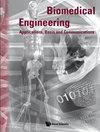MAGNETIC RESONANCE IMAGE DENOIZING USING A DUAL-CHANNEL DISCRIMINATIVE DENOIZING NETWORK
IF 0.6
Q4 ENGINEERING, BIOMEDICAL
Biomedical Engineering: Applications, Basis and Communications
Pub Date : 2023-12-01
DOI:10.4015/s1016237223500370
引用次数: 0
Abstract
Magnetic Resonance Imaging (MRI) provides detailed information about soft tissues, which is essential for disease analysis. However, the presence of Rician noise in MR images introduces uncertainties that challenge medical practitioners during analysis. The objective of our research paper is to introduce an innovative dual-channel deep learning (DL) model designed to effectively denoize MR images. The methodology of this model integrates two distinct pathways, each equipped with unique normalization and activation techniques, facilitating the creation of a wide range of image features. Specifically, we employ Group Normalization in combination with Parametric Rectified Linear Units (PRELU) and Local Response Normalizations (LRN) alongside Scaled Exponential Linear Units (SELU) within both channels of our denoizing network. The outcomes of our proposed network exhibit clinical relevance, empowering medical professionals to conduct more efficient disease analysis. When evaluated by experienced radiologists, our results were deemed satisfactory. The network achieved a noteworthy improvement in performance metrics without requiring retraining. Specifically, there was a ([Formula: see text])% enhancement in Peak Signal-to-Noise Ratio (PSNR) values and a ([Formula: see text])% improvement in Structural Similarity Index (SSIM) values. Furthermore, when evaluated on the dataset on which the network was initially trained, the increase in PSNR and SSIM values was even more pronounced, with a ([Formula: see text])% improvement in PSNR and a ([Formula: see text])% enhancement in SSIM. Evaluation metrics, such as SSIM and PSNR, demonstrated a notable enhancement in the results obtained using our network. The statistical significance of our findings is evident, with [Formula: see text]-values consistently less than 0.05 ([Formula: see text] < 0.05). Importantly, our network demonstrates exceptional generalizability, as it performs remarkably well on different datasets without the need for retraining.使用双通道鉴别去噪网络进行磁共振图像去噪
磁共振成像(MRI)提供了软组织的详细信息,这对疾病分析至关重要。然而,在磁共振图像中,医生噪声的存在引入了不确定性,挑战医疗从业者在分析。我们的研究论文的目的是引入一种创新的双通道深度学习(DL)模型,旨在有效地去噪MR图像。该模型的方法集成了两个不同的路径,每个路径都配备了独特的归一化和激活技术,促进了广泛的图像特征的创建。具体来说,我们在去噪网络的两个通道中结合参数整流线性单元(PRELU)和局部响应归一化(LRN)以及缩放指数线性单元(SELU)使用群归一化。我们提出的网络结果显示出临床相关性,使医疗专业人员能够进行更有效的疾病分析。当由经验丰富的放射科医生评估时,我们的结果是令人满意的。该网络在不需要再训练的情况下实现了性能指标的显著改进。具体来说,峰值信噪比(PSNR)值提高了([公式:见文本])%,结构相似指数(SSIM)值提高了([公式:见文本])%。此外,当对网络最初训练的数据集进行评估时,PSNR和SSIM值的增加更加明显,PSNR提高了([公式:见文本])%,SSIM提高了([公式:见文本])%。评估指标,如SSIM和PSNR,显示了使用我们的网络获得的结果的显着增强。我们的研究结果的统计显著性是显而易见的,[公式:见文本]-值始终小于0.05([公式:见文本]< 0.05)。重要的是,我们的网络展示了卓越的泛化能力,因为它在不同的数据集上表现得非常好,而不需要再训练。
本文章由计算机程序翻译,如有差异,请以英文原文为准。
求助全文
约1分钟内获得全文
求助全文
来源期刊

Biomedical Engineering: Applications, Basis and Communications
Biochemistry, Genetics and Molecular Biology-Biophysics
CiteScore
1.50
自引率
11.10%
发文量
36
审稿时长
4 months
期刊介绍:
Biomedical Engineering: Applications, Basis and Communications is an international, interdisciplinary journal aiming at publishing up-to-date contributions on original clinical and basic research in the biomedical engineering. Research of biomedical engineering has grown tremendously in the past few decades. Meanwhile, several outstanding journals in the field have emerged, with different emphases and objectives. We hope this journal will serve as a new forum for both scientists and clinicians to share their ideas and the results of their studies.
Biomedical Engineering: Applications, Basis and Communications explores all facets of biomedical engineering, with emphasis on both the clinical and scientific aspects of the study. It covers the fields of bioelectronics, biomaterials, biomechanics, bioinformatics, nano-biological sciences and clinical engineering. The journal fulfils this aim by publishing regular research / clinical articles, short communications, technical notes and review papers. Papers from both basic research and clinical investigations will be considered.
 求助内容:
求助内容: 应助结果提醒方式:
应助结果提醒方式:


